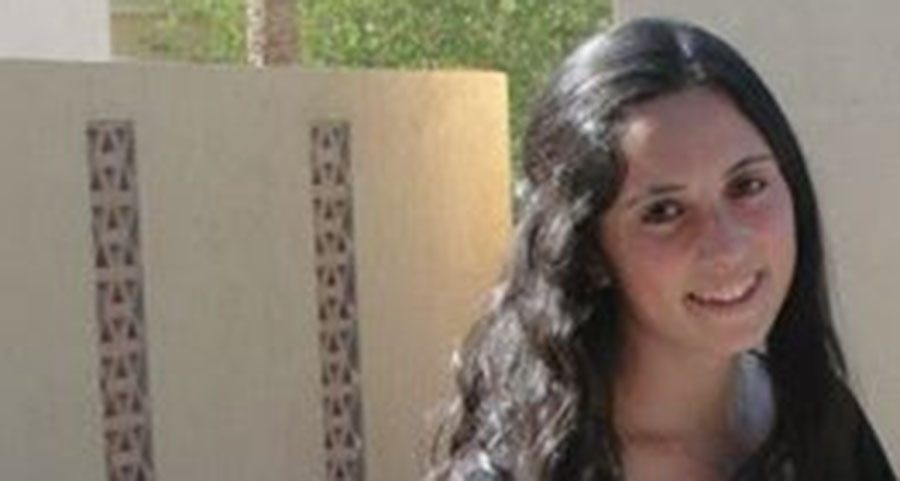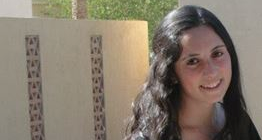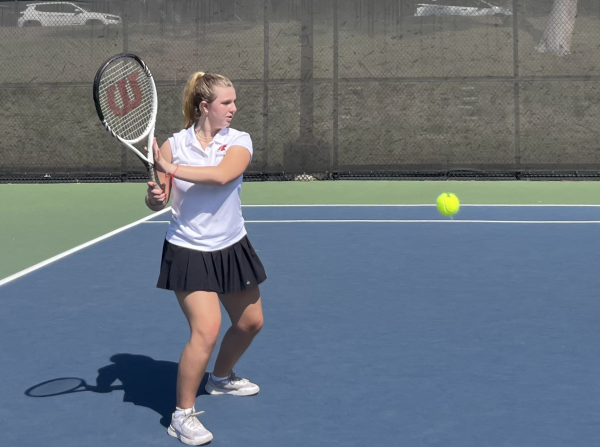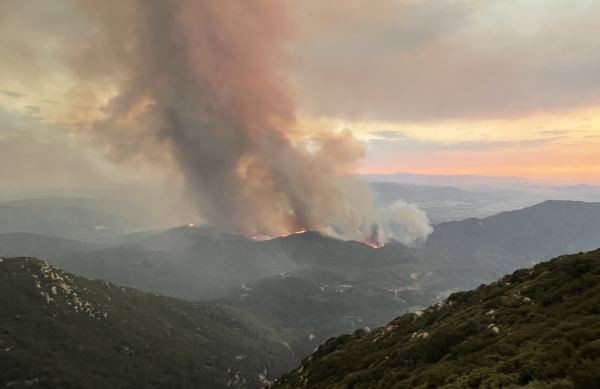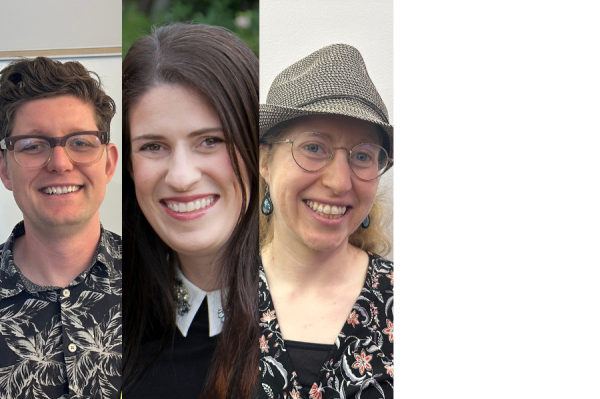The Year of Living DANGEROUSLY
Step up and get ready for a year-long wild ride
May 6, 2015
Shalhevet’s Year of Living Dangerously will come to an abrupt stop with the inauguration of the new campus to start the 2015-16 school year. No more shlepping books and binders. No more heat wave sweat stains. No more teacher parking tickets. And no more senior citizen aerobic classes.
Because I’m 18, last week I got to tour the construction site, located on the north end of what used to be our school territory. Executive Director Robyn Lewis was my guide, and Daniel Steinberg – also 18 – took pictures, many of which you can see on the Boiling Point website. In this column, I would like to personally introduce each Firehawk to a breathtaking building equipped with a multi-purpose gym, two science labs, a theater, a Beit Midrash and a Beit Knesset, along with multiple student lounge spaces and an outdoor rooftop turf.
Nine-ten South Fairfax is awaiting 240 eager, yet diverse students, to maximize every square inch of the building by taking advantage of all its resources.
As expected, the new space is adorned with a glass kippa — a shallow clear dome that sits atop the spiral staircase that connects all three floors. It shines a warm, natural light down into the foyer and creates an almost magically welcoming and comfortable atmosphere. Moreover, beams that support the dome form a Jewish Star, representing God’s presence in both the secular and Judaic realms of our school. The kippa is a monumental image that will crown the school forever.
Inside, everything is dedicated to the students. From the SAC office on the third floor overlooking the sports area to the many comfy couch corners around the building, there will always be a fun place for students to hang out. Also on the rooftop is an outdoor umbrella and table area.
Though the physical building is identical in square footage to the previous campus, it is still small enough that various grades will mingle during passing periods. With a round epicenter, it would be impossible for students not to interact en route to classes and activities – though the larger hallways will reduce the amount of forced physical contact and students pushing peers in order to be on time!
Another awesome statement the new building makes concerns the importance of the arts. While some high schools in Los Angeles are cutting art and music from the curriculum, Shalhevet continues to emphasize them. The new theater, on the first floor adjacent to the gym, is not huge, but it’s at least double the size of the Wildfire Theatre we had before.
And a huge portion of the third floor is dedicated to art and music. Roen will have a beautiful sunlit space to showcase student work and murals, as well as an outdoor area for easels and oil painting. Next door, Mrs. Keene will be teaching in the largest classroom in the school in order to accommodate the instruments, music stands and other materials required for Choir and Music Appreciation. Involvement in unconventional learning formats will be accentuated with a building that encourages out-of-the-classroom experiences.
And speaking of non-classrooms, although there are fewer classrooms in the new building than in the previous one on the same property, Rabbi Segal’s new mantra is that the school is about flexible spaces. This philosophy will allow Judaic classes to meet in a Beit Midrash and secular literature discussions to occur in the hallways’ comfy corners. The new building promotes delving into academic pursuits in progressive and productive ways.
How could I forget about the gym itself, the spacial and visual “focal point” of the school? Indoor windows on the first and second floors look overlook the beautiful regulation basketball court, which takes up almost half of the bottom floor. The gym will be used for P.E. classes (sorry freshmen – no more free periods) and can also be covered up for gala dinners or other special events.
So yes, the year of living dangerously – my senior year — will officially end at the start of school next fall. At the moment, questions related to student parking, Town Hall and co-curricular meeting locations remain unanswered. But Shalhevet will continue to soar if we all remain “flexible,” stay optimistic, and hold onto the JCC spirit.
(The JCC spirit? When this dangerous year started, who would have thought I’d be saying that?)
The Year of Living DANGEROUSLY: February 2015
As first semester comes to a close, students are finally adjusting to heavy backpacks, stair climbing and winter blankets. No lockers? No problem. No temperature controls? Ein ba’aya.
In fact, the disadvantages the JCC presents have not dimmed the Shalhevet flame’s continuous light. Application numbers are soaring and the new building is producing rapid visual advancements over on Fairfax. Sports teams are succeeding and the Just Community is reviving the democracy. Academic classes remain strong and seniors are collecting acceptances to prestigious universities.
Still, accompanying all this have been a few sharp turns, sudden halts and upside-down loops. The past couple months brought both tears of celebrity excitement and tears of mourning to the student body.
Who would have thought the antiquated 1942 Jewish Community Center attracts celebrities?
“He is playing ping pong downstairs”
“Rabbi Segal and Noey are taking pictures”
“OMG! LOL!”
The first began Nov. 5 at 3:30pm, when Justin Bieber — yes, that Justin Bieber — appeared in the foyer at the entrance to the JCC.
Wearing a red-and-white fitted Nike sweatsuit, the teenage dream swiftly and steadily walked downstairs to the Ping-Pong club, avoiding all eye contact and interaction with students. Instantly, shrieks, laughter and adrenaline filled the halls as students harassed security guards for more information on where he was, how long he’d stay and where to see him.
Those with “Bieber fever,” particularly freshmen in CIJE and girls on the basketball team, then waited for hours after school in hopes of getting an autograph or personal photo-op. In the meantime, Snapchat stories and Instagram photos were rapidly uploaded.
Eventually, Justin escaped through the emergency exit, leaving Firehawk Bieber Babies distraught.
Then, on Jan. 8 another pop star appeared. Singer Harry Styles of the hit band One Direction (Rabbi Segal’s favorite band, by the way) accompanied his floor hockey team to a game in the JCC’s Eli Sherman gymnasium.
Styles’ hot pink shirt and trendy headband sparked renewed chaos in the hallways. And this time students were able to take pictures and see the superstar in action.
Only in Los Angeles are there unexpected celebrity visits to local high schools.
But Hollywood icons and positive excitement were not the whole story.
A few weeks after Justin Bieber occupied the Ping-Pong arena, Herbert Reznikoff, the grandfather of sophomore Zev Kent and father of board member Stacy Kent, suffered a heart attack in that same room. On a Nov. 11 night excursion with his younger grandson, Eitan Kent, the familiar face and friend to many Shalhevet students passed away en route to Midway Hospital.
Herb was an active grandfather and role model to many, all of whom were shocked by his sudden death. And because it happened at school, students were even more affected and touched. The Shalhevet community expressed its sorrow to the Kent family and gathered for the funeral and shiva minyans.
Then, on Jan. 6, Steve Glouberman, father of seniors Rachel and Jeremy Glouberman and alumna Leah Glouberman ’13 and uncle of junior Elon Glouberman, passed away after battling cancer for three years. He was a supporter and friend to everyone he knew and a man dedicated to his children, family and religion. Students mourned with the entire Glouberman family, who lost a central figure and influence in their lives.
The Gloubermans received the utmost support from teachers and friends. Shalhevet hired buses to bring students to the funeral Jan. 7 and cancelled school for the remainder of the day. Teachers were especially sensitive to the seniors, who had been following Steve’s sickness since freshman year.
The faculty and student body then worked together to enable Shiva attendance – even in the heat of an end-of-semester rush of final projects and exams.
“We gathered to grieve as a unit and draw strength from one another,” wrote Head of School Rabbi Segal in an e-mail to the entire community. “Whether uniting to laugh or uniting to cry, the Shalhevet family remains strong and continues to persevere everyday.”
Clearly, the past few months have been exhilarating, heart-rending, and anything but an ordinary teenage high school experience. A year of living dangerously indeed.
A ride too hot to handle
First rollercoaster car falls off the track: HEAT hits Shalhevet.
Weather is usually an awkward conversation starter or small talk subject among strangers. This year at Shalhevet though, the weather was the dominant focus of attention within the student body and faculty for the whole first month of school.
Temperatures reached as high as 104 degrees in September and early October in West Los Angeles. Here at the JCC, it was not unusual for hallways and classrooms to reach temperatures as high as 93 degrees. You could see the temperature readings in “JCC Weather Live” on the Boiling Point’s website, updated day after day until Sukkot break.
By the end of sweaty and uncomfortable school days, students were exhausted. So the school made multiple adjustments to fight against Mr. Weatherman and friends, armpit sweat and dehydration.
Electric fans were installed in every classroom and personal fans were distributed — free from SAC (cardboard) and for $13 by Bo’s Barista Bar (hand-held electric). Administrators regularly interrupted classes to dispense cold water bottles and, if you were lucky, Otter Pops too.
Schools back east have snow days, but this year Shalhevet had heat days. From Sept. 15 through the 18, the freshmen and sophomores relocated off campus to nearby air-conditioned shuls, while the juniors and seniors used the teacher’s area, auditorium, and few air-conditioned classrooms for learning at the JCC.
Then, two days before Yom Kippur, Rabbi Segal cancelled school altogether for the next day. It’s one thing to fast, he said, and another to fast after a day of dehydration at school. Most students stayed home, but a hefty handful came to school in the morning for voluntary learning about Yom Kippur.
Even as temperatures cooled down enough to have all four grades at the JCC, leading up to Sukkot break the non-air conditioned third floor was still in the 80s. At that point, many teachers moved their classes to the auditorium — a possibility only when the JCC’s senior aerobics class was not in session. Three or four classes could learn in the auditorium at a time, separated by mechitzot used for davening.
Usually, LA’s sweltering summers taper off by mid September. Not in 2014. Even after Sukkot break, when the heat was supposed to dwindle but temperatures in the low 80s were still common upstairs.
So how did Firehawk Nation manage?
Whatever brand of water distributed during the day must have been magical. Students were not complaining about the heat, nor were they whining over the locker situation or even the overcrowded staircase.
The freshmen were adopting the positivity and optimism of most upperclassmen, while the faculty remained outwardly supportive and understanding of the school’s adventurous year-long endeavor.
But hang on, because the next derailment of the Shalhevet rollercoaster may be winter. Just as most rooms don’t have air conditioning units, they also do not have heat.
“At the JCC, the winters are even more excruciating than the summers,” said an IKAR coordinator as she walked by a group of sophomore boys eating breakfast.
The JCC’s permanent workers from IKAR and the JCC itself have warned students to bring blankets, sweaters, slippers and warm socks to school. They claim that offices get colder than the outside temperature, especially early in the morning.
Classrooms, they said, would reach temperatures as low as 50 degrees on the third floor – another unfavorable environment in which learn and engage.
Of course space heaters are less expensive than air-conditioners – So stay on board. The next swerve will be here soon enough!
November 12th, 2014
First rollercoaster car falls off the track: HEAT hits Shalhevet.
Weather is usually an awkward conversation starter or small talk subject among strangers. At Shalhevet though, the weather was the dominant focus of attention within the student body and faculty for the whole first month of school.
Temperatures reached as high as 104 degrees in September and early October in West Los Angeles. Here at the JCC, it was not unusual for hallways and classrooms to reach temperatures as high as 93 degrees. You could see the temperature readings in “JCC Weather Live” on the Boiling Point’s website, updated day after day until Sukkot break.
By the end of sweaty and uncomfortable school days, students were exhausted. So the school made multiple adjustments in the constant fight against
Mr. Weatherman and his exhaustive armpit sweat and dehydration.
Electric fans were installed in every classroom but personal fans were distributed free from SAC (cardboard) and for 13$ by Bo’s Barista Bar (hand-held electric). Administrators routinely interrupted classes to dispense cold water bottles and, if you were lucky, Otter Pops too!
Schools back east have snow days, but this year Shalhevet had heat days. From Sept. 15 through the 18th, the freshman and sophomores relocated off campus to nearby air-conditioned shuls, while the juniors and seniors used the teacher’s areas, auditorium, and few air-conditioned classrooms for learning at the JCC.
Then, two days before Yom Kippur, Rabbi Segal cancelled school altogether for the next day. It’s one thing to fast, he said, and another to fast after a day of dehydration at school.
Even as temperatures cooled enough to be at the JCC, leading up to Sukkot break the non-air conditioned third floor was still in the 80s, and many teachers moved their classes to the auditorium — a possibility only when the JCC’s senior aerobics class was not occupying the space, of course. But three or four classes could learn in the auditorium at a time, separated by mechitzot used for davening.
Usually, LA’s sweltering summers taper off by mid September. Not in 2014!
So how did the Firehawks continued to persevere?
Whatever kind of sugar cereal provided during breakfast and whatever brand type of water distributed during the day must have been magical. Students across the board were not complaining about the penetrating heat, nor were they whining over the locker situation or overcrowded staircase.
The freshmen were quickly adopting the positivity and optimism of most upperclassmen, while the faculty remained outwardly supportive and understanding of the schools adventurous year-long endeavor.
Though after Sukkot break the heat was supposed to dwindle, temperatures in the low 80s were still common upstairs. Normally, temperatures average roughly in the low 70’s until December.
But the next derailment of the Shalhevet rollercoaster may be winter. Just as most rooms don’t have air conditioning units, they also do not have heating units.
“You won’t be complaining about the heat in a couple months,” said an IKAR coordinator as she walked by a group of sophomore boys eating breakfast. “At the JCC, the winters are even more excruciating than the summers!”
The JCC’s permanent workers – staffers IKAR and the JCC itself – have warned Shalhevet students to bring blankets, sweaters, slippers and warm socks to school in the winter. They claim that in past years, offices are colder than the outside temperature, especially early in the morning.
Classrooms, they said, would reach temperatures as low as 50 degrees on the third floor – the opposite extreme of an unfavorable environment to pursue engaging and active learning.
Of course space heaters are less expensive than air-conditioners – So stay on board. The next swerve will be here soon enough!
September 9, 2014
Welcome to the beginning of a schoolwide Shalhevet-esque adventure, Firehawk Express. Please keep your head high, sit up straight, and maintain a positive attitude throughout the ride. There may be backpacks and school supplies to stumble over along the way, but buckle up your seatbelts and enjoy the thrills.
First upside down loop – watch out! Basic necessities such as lockers will not be present at the JCC. Will there be piles of binders and textbooks lining the newly painted colorful walls? Will students be lugging a backpack, lunchbox and handbag for extra school supplies up and down the stairs each day? Either way, all the students are on the same roller coaster ready to embark on uphill loops, and look out!
First downhill drop – another necessity, the air conditioning for summer and heater for the winter, will not be available along the single green-and-blue hallway of classrooms on the third floor of the JCC. Get ready for big circle sweat stains each time a classmate lifts his or her arm until about November and big ski jackets lying around the building all winter long.
The various fans placed throughout the school may help neutralize the temperature, but will definitely bring along noise too! And don’t forget about the Metro and Big Blue Buses that pass by on Olympic just about every four minutes and 38 seconds to throw some corkscrew spins through the open windows of the classrooms on the north side of the JCC, all to enhance your roller coaster experience.
Crash! Where is P.E. going to be? Will students have a gym or have to improvise in the auditorium? Look out! Another high-speed turn! Can students swim in the pool before school without official separate JCC membership? Loop de-loop! Is it reasonable for students to park in the Shalhevet lot on San Vicente and Fairfax while teachers have to find street parking around the JCC? Or ask for students and teachers to lug their English books, math texts, laptops, I-pads, papers and roller backpacks up four flights of stairs multiple times a day?
Along with all the doubts and skepticism flooding the Firehawk Express line, eagerness and anticipation await in the beautiful outdoor lunch area. Multiple round tables and benches along the outdoor stage create a perfect environment for free periods, group meetings and student lounge conversations along with breakfast and lunch.
Climbing.. climbing… right bend and drop! More new turns in the rollercoaster include the placement of Town Hall and the shared building space.
Town Hall will not only be on Tuesdays, but also last period. Will seniors stay to offer intelligent comments and experienced advice to the younger grades? In regard to sharing space, will the IKAR Hebrew School and other groups respect students’ belongings?
Screech! Crack! Fall! Eeek! You have successfully completed your first time on the Firehawk Express. You may unbuckle your seatbelts and may – or may not — enjoy the rest of your time here at Shalhevet.
Welcome to the year of living dangerously.
Just one thing – remain optimistic about the situation. It’s a transition year for the school and soon enough Shalhevet will have its own gym for PE, its own parking structure for students and teachers, its own air conditioning and last but not least, its own new set of spacious lockers.
But it will still have stairs.

